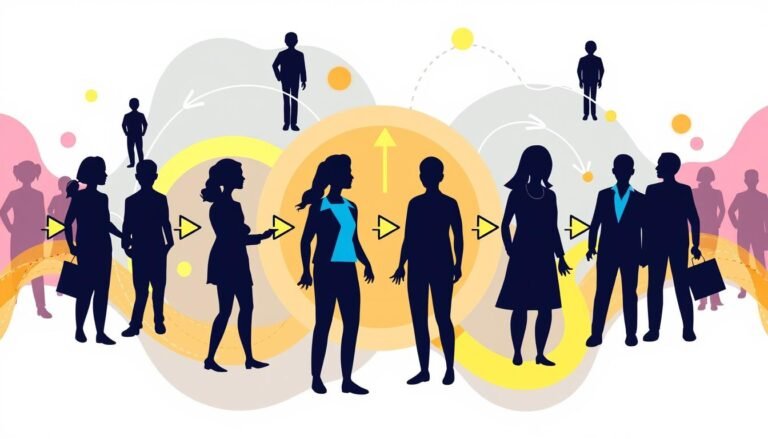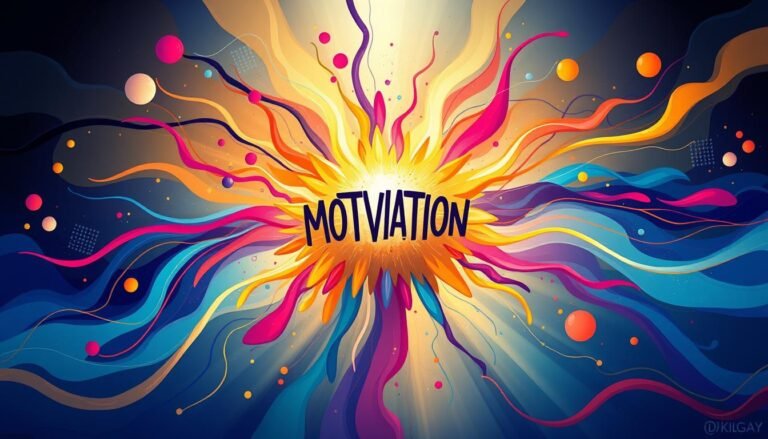Organizational Psychology Frameworks for Improving Performance Management in Irish Firms
Imagine an Irish accounting firm battling high turnover and disengaged workers. They spent a lot on new hires, but productivity fell and morale sank. Now, see this firm turned around. Workers are engaged, little turnover, and productivity is way up. The change? Using Organizational Psychology Frameworks and targeted actions for Performance Improvement.
Thinking in line with organizational psychology can change how firms manage performance. Over half of the U.S. workforce feels disconnected, which hurts productivity and causes big costs when they leave. Every year, this loss adds up to over a trillion dollars for U.S. companies alone.
Yet, firms that get employees on board thrive, with three times better margins and 22% more profit. Neglecting to appreciate employees is the top reason they quit, shared by nearly 80% of leavers. Plus, over 70% believe they would do better with more corrective feedback.
Looking closer, Irish companies using organizational psychology frameworks and High Performance Work Systems (HPWS) really leverage success. Studies in China and Ireland show these strategies link to better organizational cohesion and overall gains. These benefits include more profit, better services, new ideas, and stronger relationships.
The primary aim is to blend strategic HRM with how we review and develop workers. This way, everyone contributes towards common goals. Let’s see how pushing for these changes results in lasting success for Irish ventures.
Key Takeaways
- Over half of American employees are disengaged, impacting productivity and turnover.
- Employee engagement can lead to three times higher operating margins and 22% greater profitability.
- Lack of recognition drives nearly 80% of employee turnover.
- Corrective feedback could improve performance according to 70% of surveyed employees.
- Organizational Psychology Frameworks, when adopted, drive significant performance improvements in Irish firms.
- High Performance Work Systems are linked to better financial outcomes, productivity, and innovation.
Introduction to Organizational Psychology
Organizational psychology looks at how people behave at work. Its goal is to make work better for both employees and the company. It has deep roots reaching back to the early 1900s. Back then, it helped shape how we think about work and people at work.
Definition and Importance
Organizational psychology deals with many issues like picking the right people for a job, keeping them motivated, and working well in groups. By understanding these things, organizations can be nicer places to work. It’s about more than just HR tasks; it’s about real, ongoing talks that make work better for everyone.
Historical Context and Evolution
Its history begins in the 1900s when psychologists first looked at how people work. This led to today’s approach, which aims to tackle new workplace challenges. This includes making sure workers are happy, engaged, and feel motivated to do their best.
Today, a big change is happening in how we give feedback. Instead of just doing it once a year, we talk about work goals all the time. This new way makes communication better and helps people grow in their jobs.
| Key Components | Role in Performance Management |
|---|---|
| Motivation Theories | Motivate and satisfy employees by meeting their different needs more directly. |
| Feedback Processes | Make discussions more effective by concentrating on particular areas and involving employees in planning. |
| Leadership Development | Match leadership styles to boost how teams work together and feel about their work. |
| Team Dynamics | Increase teamwork and how well teams do through effective team-building efforts. |
In places like Ireland, using organizational psychology ideas is making work better. It helps companies work more efficiently and helps employees feel valued and motivated.
The Role of Strategic Human Resource Management
Strategic Human Resource Management (SHRM) is vital for better company performance. It links HR practices with the goals to give firms a competitive edge. It all started in the 1980s. Back then, HR management was seen as a way to make the best use of employees as assets.
High Performance Work Systems (HPWS)
High Performance Work Systems (HPWS) are key in SHRM. They aim to boost what employees can do, how motivated they are, and their chances to succeed. This leads to better overall company performance. HPWS includes things like how you hire, train, appraise performance, and introduce new employees.
Research shows a clear link between using HPWS and getting better company results. This includes being more innovative and having stronger relationships.
Mediating Mechanisms in SHRM
SHRM’s effects on a company’s success go through several steps. Employee feelings and actions come first, affecting work teams and how well the company uses resources. By adapting quickly, companies can stay successful in changing times.
Good HR practices make employees feel more in control. They encourage things like working out problems together and rewarding team effort. This makes a company’s goals match its actions better, leading to improved success.
Benefits for Firms
SHRM brings many benefits to firms. Those who combine strong HR practices with good employee feedback and rewards see better results. This not only improves performance but also helps a company stay ahead in the long term.
Research shows that when HR strategies are well thought out, employees feel more confident, are more likely to speak up, and are more innovative. Such a complete approach to HR leads to better work, happier employees, and company success.
| HPWS Practices | Positive Outcomes |
|---|---|
| Effective Recruitment | Increased Talent Acquisition |
| Comprehensive Training | Enhanced Skills and Abilities |
| Empowering Incentives | Higher Motivation and Engagement |
| Performance Appraisal | Improved Employee Performance and Satisfaction |
Performance Management Systems in Irish Firms
Performance Management Systems in Ireland are changing a lot. Companies are moving from old to new ways of HR, showing new goals.
Traditional Methods vs. Modern Approaches
Yearly reviews are no longer the norm in Ireland, with just 28% still using them. A global change sees big companies using more regular feedback for employee development. This shift away from old methods has become common in Irish businesses too. They use more frequent and 360-degree feedback to get a better overview of their workers’ performance.
Firms in Ireland are now adopting agile management, which means quick changes and better flexibility. This new way of working focuses on giving and receiving feedback to improve job performance for the goals ahead.
Integration of Organizational Psychology
The Irish business world is joining personal and business aims through organizational psychology in their performance reviews. By using these psychological principles, they encourage continuous feedback, clear goals, and employee support for growth.
Surveys show that using data and artificial intelligence is helping 92.1% of organizations in making better choices for staff management. Big companies like Amazon show us that using data well really impacts sales. They rely on these strategies. Additionally, big names like Microsoft and Adobe boost their staff with workshops and digital learning, emphasizing the value of constant updates for today’s business staff.
- Performance Management Systems in Irish firms are increasingly adopting modern, continuous feedback mechanisms.
- Integration of organizational psychology bridges personal and organizational goals.
- Agile performance management supports rapid development and adaptability.
- Data and AI-driven strategies enhance decision-making and performance.
| Country | Percentage Utilizing PMS |
|---|---|
| UK | 90% |
| Greece | 88% |
| Ireland | x% |
| Germany | 81% |
This new approach shows a broad effort towards more up-to-date, data-focused, and psychologically aware business practices. The aim is to have better work environments that focus on getting better and caring for staff well-being.
The Importance of Employee Motivation Theories
Knowing about employee motivation theories helps organizations boost their teams’ performance. These ideas help us understand what makes employees get involved and work harder. For example, Irish companies find these theories very useful for their HR strategies. By applying these theories, they can improve how their employees work and contribute.
Key Theories and Models
Maslow suggested we have different needs, from basic ones like food and shelter, to more complex needs like achieving our full potential. Herzberg said workplace satisfaction is influenced by different things than dissatisfaction. Meanwhile, Vroom highlighted how we think about the results of our work affects our effort.
Researchers like Donovan J.J. and Olafsen tested these theories over time. They found that ideas such as the importance of feeling autonomous and competent influence our work in significant ways. Such theories were later developed by Ryan and Deci, focusing on how intrinsic motivation really drives us.
Application in Performance Management
For Irish firms, motivating employees is key to creating a successful work culture. They can do this by supporting what truly motivates their employees. For example, giving them a say in how they do their work, making them feel skilled, and connecting them to others at work can be more powerful than just paying them more.
Research shows that when our basic needs are met at work, we grow in ways that benefit both our own happiness and our job performance. Organizations that offer tasks that are clear, challenging, and meaningful see their teams perform better. They also keep their team members happier and more loyal.
In practice, companies can use these theories to change how they manage their employees’ work. For instance, by reorganizing job roles so that more motivating tasks are part of everyday work. They can also make sure employees’ personal goals align with what the organization is trying to achieve.
Overall, using these motivation theories in HR practices not just boosts performance. It also makes workplaces where everyone feels connected, stays motivated, and supports each other. This is the kind of environment where companies succeed in the long run.
- Improved Employee Engagement
- Increased Productivity
- Enhanced Job Satisfaction
- Higher Staff Retention
- Holistic Workforce Well-being
| Motivation Theory | Key Insight | Application in Task |
|---|---|---|
| Maslow’s Hierarchy | Basic to Self-actualization Needs | Address fundamental needs for better engagement |
| Herzberg’s Two-Factor | Dual Factors: Hygiene and Motivators | Improve conditions and recognize achievements |
| Vroom’s Expectancy | Outcome Expectations Drive Behavior | Align employee goals with outcomes |
Leadership Development Programs: A Key to Success
Leadership development programs are key to an organization’s success. They train future leaders and create a culture of growth and execution. By including training, mentorship, and planning for the future, these programs build a strong group of leaders. They prepare them for the many challenges they will face.
Elements of Effective Programs
To be strong, leadership programs need a few key elements. These elements ensure that growth is real and results can be seen:
- Vision: It’s important for the program’s goals to match the company’s strategic plan.
- Method: Mixing different training methods, like learning by doing and mentorship, boosts skill development.
- Impact: It’s vital to check how the program affects both careers and the company’s success. This helps in making the program better over time.
Some leaders don’t create a safe space, and that’s a big problem when it comes to teamwork. Programs can help by teaching leaders to be more consultative and supportive. These leadership styles are known to increase safety and improve how teams work together.
Impact on Organizational Performance
Leadership programs boost how well a company does by giving leaders the tools to meet goals, develop talent, and create a strong culture. When psychological safety is high, teams work better together. This happens because of how leaders support and challenge their teams.
| Leadership Style | Impact on Psychological Safety |
|---|---|
| Consultative Leadership | Direct impact (regression coefficient of 0.54) |
| Supportive Leadership | Indirect but significant effect |
In Ireland, companies focused on strong leadership programs could do very well. These programs use solid training, real-world practice, and ensure that progress is constantly checked. When leaders are stretched to grow, companies usually see better leadership and results as an outcome.
Talent Management Strategies for Irish Firms
In Irish companies, effective talent management is essential. It helps use the unique skills and knowledge of the staff. This builds a culture where excellence and new ideas thrive.
Recruitment and Selection Processes
In Ireland, strong recruitment plans are key for managing talent. These include thorough selection methods to bring in skilled people. These methods look for those who fit the company’s culture and values too.
For example, companies might use the 9-box grid to spot “high-potentials” and “high-performers”. It’s vital because only 3 to 5% of a company’s team might be truly talented. So, finding and hiring them is very important.
Retentive and Development Strategies
Keeping and growing talent is important for staying ahead in Ireland. Companies should keep investing in things like career growth, training, and performance incentives. This keeps the team happy, motivated, and loyal.
Studies show that smart talent management boosts a company’s image and profits. It also makes customers happier.
Managing performance well is also vital. It gives clear information for decisions, highlights training needs, and keeps the team motivated. When this wasn’t done well during COVID-19, staff engagement dropped and more people left their jobs. So, it’s crucial to have strong talent strategies. These strategies help keep top talent and lead to a successful company.
| Strategy | Benefits |
|---|---|
| Comprehensive Recruitment | Aligns candidates’ skills with organizational needs |
| Use of 9-box Grid | Identifies high-potentials and high-performers |
| Career Development Programs | Enhances employee satisfaction and motivation |
| Performance Incentive Schemes | Boosts productivity and operational excellence |
| Continuous Training | Fosters commitment and trust in leaders |
Workplace Behavior Analysis Techniques
It’s key for companies to understand and enhance workplace behavior. This improves how well everyone works. By studying how people act and react, businesses can make better work places. These methods help growth in the long run.
Methods and Tools
There are many ways to look at how employees behave at work. Some methods include:
- DISC Behavioral Analysis: DISC focuses on four main personality types. It helps understand how people work together.
- Myers-Briggs Type Indicator (MBTI): This tool shows people’s different ways of thinking. It makes working together easier by placing people in roles they prefer.
- Custom Solutions: Companies like Audra create special solutions for all sorts of work needs. They help with hiring, keeping track of how people are doing, and ensuring employees are alright. This keeps companies moving forward smoothly.
In 2015, DiGennaro Reed and Henley found something important. Only 55% of workers felt they had enough training when they started. But, 71% got help later on, mostly through talks or monthly check-ins. This proves that good training and studying how people work need to be ongoing. This helps staff do their best.
Interpreting Results for Improved Performance
Looking at how people act at work shows some key things:
- Performance Tracking: By keeping an eye on how workers and teams do, issues can be found and fixed. Also, great work can be noticed.
- Employee Burnout: Watching closely helps find early signs of burnout. This lets companies step in before it gets bad.
- Resource Allocation: Seeing how people work best helps use resources wisely. This makes things run better.
A 2015 survey by Kazemi, Shapiro, and Kavner showed something big. Happy workers who like their training and bosses want to stay. That’s why using good analysis can keep people from leaving. High turnover costs companies a lot per worker. This was highlighted by Sundberg in 2016.
Studying how people behave is crucial for better communication and teamwork. In Ireland, using these ideas can boost productivity. It creates a place where everyone does their best work. And where improvement is always happening.
Assessment of Organizational Culture
The Organizational Culture Assessment Instrument (OCAI) is key for looking into how organizations work. Kim Cameron and Robert Quinn made it at the University of Michigan in 1999. It follows the Competing Values Framework, which is used by more than 10,000 companies. The OCAI looks at an organization’s culture from four angles: Create Culture (Adhocracy), Collaborate Culture (Clan), Control Culture (Hierarchy), and Compete Culture (Market).
Organizations put points into these areas to show their focus on things like change and how they interact with the world. This approach shows a company’s cultural style visually. It’s important that a company’s cultural direction matches its Irish values and future plans.
People within the organization score the culture using six different parts. They divide the points to show where the culture is now and where they’d like it to be. This approach helps make a friendly work environment analysis by pointing out what to work on. Most organizations mix these culture types uniquely, leading to certain cultural mixes.
Studies by Denison, Howard, and others confirm the value of the Culture Assessment system. This system connects with how people think and act, bonding, learning, and protecting. It also matches with common personality models, like the “Big Five” and MBTI, proving its reach.
Ties between culture and how happy people are at their jobs, how dedicated they are, and their results are well supported. Research in places like the Russian Journal of Agricultural Socio-Economic Sciences reinforces these ideas. It shows how culture checks can shape a company’s path.
| Organizational Culture Type | Characteristics | Preferred for |
|---|---|---|
| Create Culture (Adhocracy) | Innovative, Flexible, Risk-Taking | Dynamic, Entrepreneurial Environments |
| Collaborate Culture (Clan) | Family-Like, Loyal, Team-Oriented | Employee Engagement, Involvement |
| Control Culture (Hierarchy) | Structured, Formal, Efficiency-Focused | Stable, Well-Structured Environments |
| Compete Culture (Market) | Competitive, Goal-Oriented, Market-Driven | Results, Achieving Objectives |
An in-depth look at the work environment and matching it with Irish values can improve the workplace. This leads to a more motivated team and better results. It shows the big impact of understanding a company’s culture on its success.
Change Management Processes in Performance Management
Change management is key for boosting how well organizations run. Knowing what drives changes, and the hurdles in the way, helps organizations improve. Using strong change management plans makes changing easier. This, in turn, leads to better work cultures in Irish firms.
Driving Factors and Challenges
Many things make good change management in companies important. Leaders changing, companies growing fast, and the big effect of crises need careful handling. Also, if goals are not met, how performance is managed must be changed for the better.
- Changes in leadership
- Rapid company growth
- The impact of crises, such as the COVID-19 pandemic
- Failure to meet organizational goals
When it comes to change, there are key hurdles to overcome. Employees might push back against new ways. Also, meeting goals could clash with how performance is tracked. Making sure everyone involved is on board is a must.
- Employee resistance to new management practices
- Misalignment between organizational goals and performance management systems
- Insufficient stakeholder engagement
Effective Change Management Frameworks
Using good frameworks can help everyone get on board with changes. There are several models that have proven to work:
- Lewin’s Change Management Model: This model sees change in three stages: Unfreeze, Change, Refreeze.
- The McKinsey 7-S Model: It looks at seven elements that need to be aligned for success.
- Kotter’s 8-Step Process: Focuses on sparking urgency, bringing everyone together, and setting a clear goal.
- The ADKAR Model: Concentrates on five key areas for successful change: Awareness, Desire, Knowledge, Ability, and Reinforcement.
- Nudge Theory: Suggests guiding change through gentle pushes, like using suggestions and feedback.
- The Bridges Transition Model: Helps navigate through the end of the old way, a neutral zone, and the start of something new.
- The Kübler-Ross Change Curve: It explains the emotional process of change through five stages.
- The Satir Change Model: It describes how people experience change from the early signs to finally accepting it.
To sum up, putting in place robust change management methods is crucial for hitting peak performance and staying flexible. Irish firms, by focusing on clear talks, managing risks, and bringing everyone onboard, can build a stronger future of ongoing success.
Employee Engagement Initiatives
In today’s world, making employees feel connected and focused is very important. Sadly, not many employees are fully engaged in their work. Only about 23% worldwide and 33% in the U.S. really feel involved. This shows that there’s a big chance for companies to do better. Businesses that focus on engaging their workers make about 21% more money and are 17% more productive. So, it’s clear how much good engagement strategies can influence a company’s success.
Innovative Approaches
There are new and exciting ways to get employees more involved. These include giving them more freedom to connect with each other and grow. Groups of employees with their own power can become close and make choices fast, raising their interest in their job. Experts say that 70% of a team’s happiness comes from their direct boss. This makes it vital to train leaders well. Tools like those from ContactMonkey help companies see how well their efforts to engage employees are working. This helps them make changes for the better.
Measuring Engagement Success
How do companies know if their plans to engage employees are working? They look at different signs like how likely employees are to recommend their workplace to others. They also check if workers are staying with the company and how well teams are doing their jobs. Lower rates of lost products, missing work, and accidents are also checked. Companies with happy teams have less waste, fewer people missing from work, and fewer accidents. By regularly checking and improving their engagement strategies, companies in Ireland can become more productive and make more money. They can also be places where people enjoy working, which is very important.
FAQ
What are organizational psychology frameworks?
Organizational psychology frameworks are structured methods. They improve how employees experience work and increase productivity. These are key tools for making organizations perform better.
How has organizational psychology evolved over time?
Since the early 20th century, industrial changes influenced the field. It started focusing more on people. Now, it’s critical for making workplaces better and organizations more efficient.
What is strategic human resource management (SHRM)?
SHRM means using practices that match organizational goals to get better results. These include HPWS that help employees do their best. They boost skills and dedication for a more successful organization.
How do High Performance Work Systems (HPWS) benefit firms?
HPWS are great for businesses. They improve finances, productivity, and more. By linking employee skills and actions to the company’s success, they provide a strong HR management strategy.
What differentiates traditional performance management systems from modern approaches?
In the past, systems were about yearly reviews and looking back. Now, it’s about ongoing feedback and development talks. This change supports continuous growth and better connects with the organization’s aims.
How can employee motivation theories be applied to performance management?
Theories such as Maslow’s or Herzberg’s help us understand what makes employees engaged and productive. Using these in management strategies creates a work culture that values both the employees and the company.
What are the key elements of effective leadership development programs?
Great programs have focused training, mentorship, and plans for the next leaders. They help leaders meet strategic goals, grow talent, and build a strong working environment.
Why are robust recruitment and selection processes important in talent management strategies?
Hiring the right people is key to keep ahead. By focusing on attracting those who match the company’s values, and then continuing to help them grow, the organization stays competitive.
What techniques are used in workplace behavior analysis?
Tools that gather data are used to learn about how employees act, work together, and perform. This data helps companies see patterns and come up with strategies to do better.
What is the significance of assessing organizational culture?
Looking deeply at culture shows how well it fits with the company’s goals. This insight helps implement actions for a workforce that is more committed and productive.
What factors drive successful change management processes?
Knowing what can help or block new ways of working is critical. Good plans make changes easier, boosting a company’s ability to perform well and adapt.
How can employee engagement initiatives improve firm performance?
Strategies that make employees more involved can lift their spirits and their work. By checking how well these efforts do, companies can keep getting better results by tweaking their strategies.
Source Links
- Performance management templates for easy and effective cycles
- Performance Appraisal, Performance Management and Improving Individual Performance: A Motivational Framework | Management and Organization Review | Cambridge Core
- Chinese and Irish professional service firms compared: Linking HPWS, organizational coordination, and firm performance
- Organizational Psychology 101: Revolutionize the Way You Lead and Succeed
- (PDF) Industrial–Organizational Psychology and the Practice of Performance Improvement
- Strategic Human Resource Management Framework for High Performance Organizations: What does the evidence tell us? | CQ Net – Management skills for everyone
- How Does Strategic Human Resource Management Impact on Employee Voice Behavior and Innovation Behavior With Mediating Effect of Psychological Mechanism
- Frontiers | Role of Efficient Human Resource Management in Managing Diversified Organizations
- How can Irish companies implement effective performance management systems?
- Business, Management and Economics Engineering
- Performance Management: Chapter 7 in Human Resource Management
- Work Motivation: The Roles of Individual Needs and Social Conditions
- 5 Motivation Theories for Managers – Work Life by Atlassian
- 4 Employee Motivation Theories You Need To Try
- Psychological safety and the critical role of leadership development
- Leadership Development Is Failing Us. Here’s How to Fix It
- The Future of Leadership Development
- The Role of Talent Management Comparing Medium-Sized and Large Companies – Major Challenges in Attracting and Retaining Talented Employees
- Performance management in a rapidly changing world: implications for talent management
- Microsoft Word – Zora_Effectiveness of Talent Management Strategies
- Evidence-Based Performance Management: Applying Behavioral Science to Support Practitioners
- Using Behavioral Analysis in the Workplace
- Industrial and Organizational Psychology Provides Workplace Solutions
- About the Organizational Culture Assessment Instrument (OCAI)
- The Effect of Employee Competency and Organizational Culture on Employees’ Perceived Stress for Better Workplace
- DIAGNOSING AND CHANGING ORGANIZATIONAL CULTURE
- 5 steps to performance change management planning | Culture Amp
- Top 10 change management models: A comparison guide
- How can you use change management principles to implement a performance management framework?
- How to Improve Employee Engagement in the Workplace
- 3 Employee Engagement Models, Theories And Frameworks
- Performance management and employee engagement








